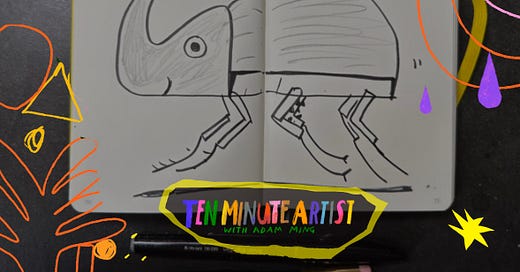Illustration: Micro Lesson and Sketchbook Project.
What’s the difference between a sketch a drawing and an illustration?
Micro Lesson: Illustration
What’s the difference between a sketch, a drawing and an illustration?
A sketch is a direct capturing of an idea or reference. It is first creation. Is a sketch a drawing? Yes if you use a drawing instrument to make the sketch. A sketch can be a kind of drawing.
A drawing can have many aspirations. A finished art work might be one. Or it could be a study in preparation for something more complete. A drawing might be more laboured than a sketch, it’s role part way between study and communication. There will be overlaps between what a drawing is and what a sketch is.
One might produce many sketches and illustrations before arriving at a final illustration.
An illustration can be made out of a sketch or a drawing, but it could also be made digitally or painted or by collage.
For our purposes, when we think of illustration. Let’s think of it as a kind of sketch or drawing. An Illustration is a drawing or sketch made for the purpose of communication.
“Style is knowing exactly what you want to say, and saying it exactly” - C.S. Lewis
An illustration is a drawing, in your style, made for the purpose of communicating your subject. If you’ve never done so before, this week you will be making your very first illustration.1
A note on style
In art school we are though to create an Artist Statement.
An artist statement is a brief written document prepared by an artist, which accompanies and explains their work. It is a personal narrative that gives viewers insights into the artist's motivations, inspirations, and the concepts behind their artwork. It often covers the artist's creative process, techniques, and the themes explored in their work.
Art schools typically require students to create artist statements for several reasons:
Clarity and Intent: It helps artists articulate the purpose and the underlying concepts of their work. This process of reflection and explanation can offer clarity to the artist themselves, as well as to their audience.
Professional Practice: Writing an artist statement is a common professional practice in the art world. It accompanies exhibitions, portfolio submissions, and grant applications, serving as an essential tool for communication about one’s work.
Critical Thinking: Crafting an artist statement encourages critical thinking about one's own work. It requires artists to analyze and evaluate their motivations, influences, and the messages they wish to convey, which is an essential skill in any creative field.
Communication Skills: It enhances artists' ability to communicate about their work with a broader audience, including gallery owners, collectors, curators, and the general public. An effective artist statement makes the work more accessible and can engage the audience on a deeper level.
Professional Development: It is part of an artist’s professional development, helping them to position their work within the broader context of the art world and to articulate their place among their peers and in art history.
Overall, the practice of writing an artist statement is seen as an integral part of an artist's education and professional development, aiding in both personal reflection and in communication with the external world.
Sketchbook Project: Illustration
Read the whole project once, then come back on the appropriate days to get that day’s assignment.
Day 1: Use your 10 minutes to write an artist statement.
Look at the sketches you’ve done so far for inspiration, how do you uniquely interpret the prompts?
Answer these questions:
I make art that looks like: _______________
My art makes me and others feel: ________________
My art is influenced by: (Artist, history, experience, culture) ______________
Based on these answers, write a short artist statement in your sketchbook.
Here is mine as an example:
“I Adam Ming, make witty and energetic illustrations with a comic sensibility.”
If you can’t come up with one yet, borrow one of these.
My art is clear communicative and witty
My art is delicate and sweet
My art is fun and chunky
All artist statements are not final and they can evolve, but for the purpose of our exercise you will need one.
Day 2-5: Sketch and Draw
Pick a subject, by subject is Bugs (other fun subject might be Dinosaurs or Birds, pick anything you like.
Make sketches and observational drawings about your subject, draw as many as you can. You can think of these research drawings. Add notes to your drawings as you make them. Don’t worry about style when drawing you, you are capturing information.
Day 6: Illustrate (No peeking)
Illustrate (draw) your subject doing something, in your style, without looking at reference. You’ve downloaded information for 4 days, now it’s time to communicate that information in your style.
Let your Artist Statement guide you.
Day 7: Illustrate (Some peeking)
Illustrate (draw) your subject doing something, in your style, feel free to look at your sketches and other references.
Let your Artist Statement guide you.
Share your process and work in the gallery,
The definitions we are using for drawing, sketching and illustration are simplifications for the benefit of scoping both the lesson and the project.






Adam, I love your prompts for the artist statement, and I actually adapted them to share with my students who were drafting their own artist statements this week! I credited you :) Thank you!
I like it.